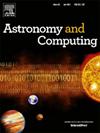Analyzing the position and stability of the Lagrangian points under the gravitational effect of the Sun, Moon and the Earth including its oblateness
IF 1.8
4区 物理与天体物理
Q2 ASTRONOMY & ASTROPHYSICS
引用次数: 0
Abstract
The present study explores the existence and stability of the Lagrangian points in the Earth–Moon–Sun system, consider the artificial satellite moving around the Earth under the gravitational attraction of the Sun, the Earth and the Moon. Equations of motion of the satellite are determined in spherical polar coordinate system with the help of potential of the Earth. The positions and stability of the Lagrangian points lie on the -axis and -axis are investigated including the effect of (oblateness of the Earth), (orbital angle of the Moon around the bary-center), (orbital angle of the bary-center system around the Sun) and (longitude of the satellite). Finally, the zero velocity curves are drawn by taking different values of Jacobi constant. It is observed that region of possible motion decreases on increasing the values of Jacobi constants
分析了拉格朗日点在太阳、月球和地球(包括其扁率)引力作用下的位置和稳定性
本研究考虑在太阳、地球和月球的引力作用下绕地球运动的人造卫星,探讨了地球-月球-太阳系统拉格朗日点的存在性和稳定性。利用地球的位势,在球极坐标系中确定了卫星的运动方程。研究了拉格朗日点在x轴和y轴上的位置和稳定性,包括J2(地球的扁率)、ν(月球绕质心的轨道角)、α(质心系统绕太阳的轨道角)和θ(卫星的经度)的影响。最后,通过取不同的雅可比常数,绘制出零速度曲线。观察到随着雅可比常数的增大,可能运动的区域减小
本文章由计算机程序翻译,如有差异,请以英文原文为准。
求助全文
约1分钟内获得全文
求助全文
来源期刊

Astronomy and Computing
ASTRONOMY & ASTROPHYSICSCOMPUTER SCIENCE,-COMPUTER SCIENCE, INTERDISCIPLINARY APPLICATIONS
CiteScore
4.10
自引率
8.00%
发文量
67
期刊介绍:
Astronomy and Computing is a peer-reviewed journal that focuses on the broad area between astronomy, computer science and information technology. The journal aims to publish the work of scientists and (software) engineers in all aspects of astronomical computing, including the collection, analysis, reduction, visualisation, preservation and dissemination of data, and the development of astronomical software and simulations. The journal covers applications for academic computer science techniques to astronomy, as well as novel applications of information technologies within astronomy.
 求助内容:
求助内容: 应助结果提醒方式:
应助结果提醒方式:


